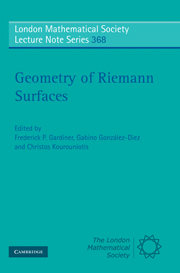Book contents
- Frontmatter
- Contents
- Preface
- Foreword
- Semisimple actions of mapping class groups on CAT(0) spaces
- A survey of research inspired by Harvey's theorem on cyclic groups of automorphisms
- Algorithms for simple closed geodesics
- Matings in holomorphic dynamics
- Equisymmetric strata of the singular locus of the moduli space of Riemann surfaces of genus 4
- Diffeomorphisms and automorphisms of compact hyperbolic 2-orbifolds
- Holomorphic motions and related topics
- Cutting sequences and palindromes
- On a Schottky problem for the singular locus of A5
- Non-special divisors supported on the branch set of a p-gonal Riemann surface
- A note on the lifting of automorphisms
- Simple closed geodesics of equal length on a torus
- On extensions of holomorphic motions—a survey
- Complex hyperbolic quasi-Fuchsian groups
- Geometry of optimal trajectories
- Actions of fractional Dehn twists on moduli spaces
Complex hyperbolic quasi-Fuchsian groups
Published online by Cambridge University Press: 05 May 2013
- Frontmatter
- Contents
- Preface
- Foreword
- Semisimple actions of mapping class groups on CAT(0) spaces
- A survey of research inspired by Harvey's theorem on cyclic groups of automorphisms
- Algorithms for simple closed geodesics
- Matings in holomorphic dynamics
- Equisymmetric strata of the singular locus of the moduli space of Riemann surfaces of genus 4
- Diffeomorphisms and automorphisms of compact hyperbolic 2-orbifolds
- Holomorphic motions and related topics
- Cutting sequences and palindromes
- On a Schottky problem for the singular locus of A5
- Non-special divisors supported on the branch set of a p-gonal Riemann surface
- A note on the lifting of automorphisms
- Simple closed geodesics of equal length on a torus
- On extensions of holomorphic motions—a survey
- Complex hyperbolic quasi-Fuchsian groups
- Geometry of optimal trajectories
- Actions of fractional Dehn twists on moduli spaces
Summary
Abstract
A complex hyperbolic quasi-Fuchsian group is a discrete, faithful, type-preserving and geometrically finite representation of a surface group as a subgroup of the group of holomorphic isometries of complex hyperbolic space. Such groups are direct complex hyperbolic generalisations of quasi-Fuchsian groups in three dimensional (real) hyperbolic geometry. In this article we present the current state of the art of the theory of complex hyperbolic quasi-Fuchsian groups.
Introduction
The purpose of this paper is to outline what is known about the complex hyperbolic analogue of quasi-Fuchsian groups. Discrete groups of complex hyperbolic isometries have not been studied as widely as their real hyperbolic counterparts. Nevertheless, they are interesting to study and should be more widely known. The classical theory of quasi-Fuchsian groups serves as a model for the complex hyperbolic theory, but results do not usually generalise in a straightforward way. This is part of the interest of the subject.
Complex hyperbolic Kleinian groups were first studied by Picard at about the same time as Poincaré was developing the theory of Fuchsian and Kleinian groups. In spite of work by several other people, including Giraud and Cartan, the complex hyperbolic theory did not develop as rapidly as the real hyperbolic theory. So, by the time Ahlfors and Bers were laying the foundations for the theory of quasi-Fuchsian groups, complex hyperbolic geometry was hardly studied at all. Later, work of Chen and Greenberg and of Mostow on symmetric spaces led to a resurgence of interest in complex hyperbolic discrete groups.
- Type
- Chapter
- Information
- Geometry of Riemann Surfaces , pp. 309 - 355Publisher: Cambridge University PressPrint publication year: 2010
- 4
- Cited by



